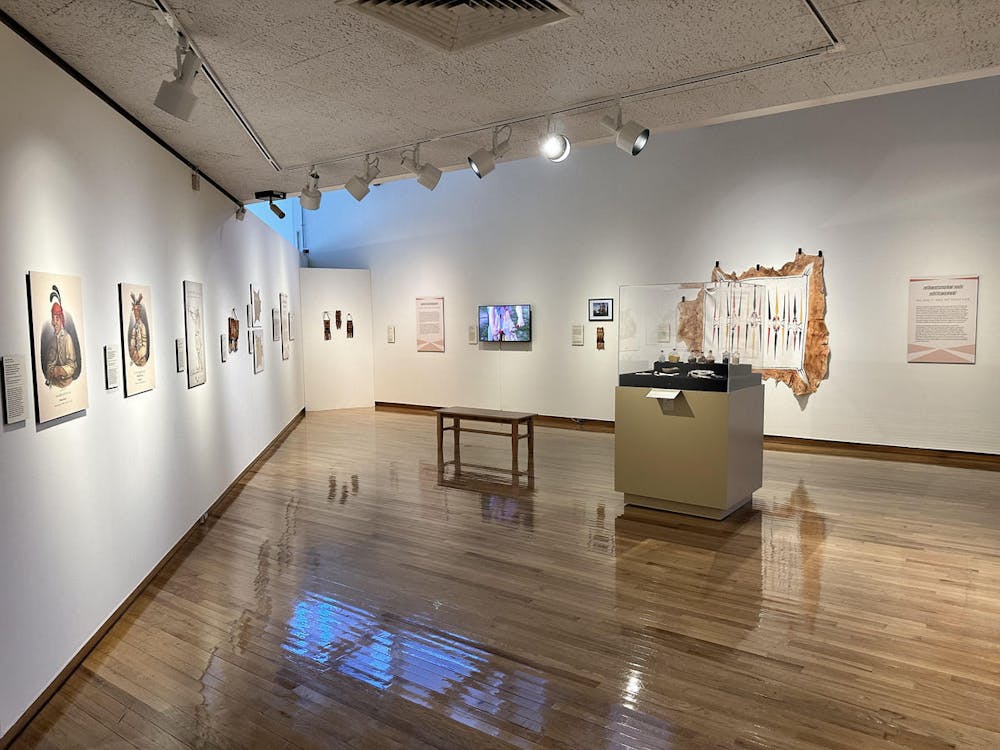The Myaamia people have been burdened with a series of forced removals, leaving behind their traditions, artwork and land. The “Reclaiming Stories” project is working to change that.
The “Reclaiming Stories” project, which began in 2020, is a team of Peewaalia (Peoria Tribe), Myaamia (Miami Tribe) and non-Native scholars working to reconnect to and reclaim the art of hide painting. Through hosting several workshops, the team has created a collection of painted robes and other artworks now on display at Miami University’s Richard and Carole Cocks Art Museum until June 8.

This is not the first time the art museum has featured Myaamia art in its exhibits
“We call it reclaiming stories because for us, seeing and being with and thinking about the robes and the contemporary art being made, gives us the chance to talk about thunders, to tell stories [and] revisit these historical contexts … [it’s] important to the broader revitalization work,” said Elizabeth Ellis, history professor at Princeton University and member of the project.
Minohsayaki, or painted hide robes, are a significant part of Peewaalia and Myaamia history. This art form eventually served as a gift of alliance to the French during the 17th and 18th centuries, with several painted robes from the Myaamia and Peewaalia people currently featured in the Musée du Quai Branly - Jacques Chirac in Paris, France.
The robes are made using natural pigments on deer or bison hide, and many are on display at the museum. Ground hematite and charcoal are commonly used as pigments.

The exhibit featured works from Myaamia, Peewaalia and non-Native scholars through the "Reclaiming Stories" project
“It’s reclaiming and invigorating an aesthetic of beauty for Myaamia people that’s unique,” Cameron Shriver, Myaamia Center historian and professor, said.
Distinct shapes, patterns and colors — red, yellow, blue, white, clear and black — are characteristic of Myaamia robes. Current research from Reclaiming Stories suggests the shapes may symbolize specific characters in Aalhsookhaana (the winter stories), as well as thunder and hailstones which represent power.
“If we think about the robes and the stories embedded in the robes … they were thinking very specifically about the kinds of messages of power, spiritual might and identity that they wanted to share with the French,” Ellis said.
Participants in Reclaiming Stories attended workshops across two summers to create replicas of traditional art ranging from blankets and coats to bags and robes. Many of these pieces are displayed at the exhibit, featuring art from Ellis, Shriver and George Ironstrack, assistant director of the Myaamia Center and historian on Myaamia topics.
“I was really fascinated to get to experiment with the processes, especially making pigments from minerals and applying them with either a binder, which in this case we’re using egg yolk, which historically hide glue is probably the most common thing used, but also to apply pigment with my fingers,” Ironstrack said.
Enjoy what you're reading?
Signup for our newsletter
Ironstrack’s painted bag is on display at the museum. He is not a practicing painter, but he learned many techniques along the way.
“There’s a lot of hand application of pigment or to ground into the fibers of the hide in a really interesting way,” Ironstrack said. “So I really enjoyed experimenting with those two different methods of applying and I learned a lot of lessons like I painted too close to the edge of the bag, so then when I assembled the bag together, a part of the design smeared.”

Minohsayaki, or painted hide robes, are a significant part of Peewaalia and Myaamia history
In the future, the “Reclaiming Stories” team hopes to take a trip to France with a much larger group and a set focus on the project to bring learning back into the community.
Ironstrack said there is still a lot of work to do and more meaning to discover.
“If you visit the exhibition, what you’ll see is a story that’s about work in progress and communities,” Ironstrack said.
This is not the museum's first exhibit showcasing works of the Miami Tribe, and it likely won’t be the last. However, there are not any future exhibits currently planned with the art museum.
“We expect there to be future exhibits, as well as other workshops and other means of sharing the knowledge once the story feels more complete to us in this work of reclaiming knowledge from France,” Ironstrack said.
The museum first featured Myaamia art in 2003. In 2008, it held its “myaamiaki iiši meehtohseeniwiciki: How the Miami People Live” exhibit, celebrating the vibrant heritage of the community with artifacts and objects from the Miami Tribe. Other past exhibits include Myaamia Ribbonwork in 2020 and “Interconnected: Land | Identity | Community” in 2022, which featured some Myaamia student artwork.
“I think it’s really important for the Miami University community to see living examples of Myaamia presence in their homelands,” Shriver said. “Miami is a good place to have living and vibrant examples of Myaamia art, language, culture and history.”
After June 8, the exhibit will move to Oklahoma to share the learning with the Myaamia and Peewaalia community.
Michael Galban, historic site manager of the Seneca Art and Cultural Center, will hold an accompanying program titled “Requickening and Awakening the Dormant” on March 16 from 3-5 p.m.
Indigenous communities have historically been misrepresented and inaccurately reported on by the press, including The Miami Student. To address this history, we work with Stella Beerman, Myaamia Adviser to The Miami Student, to ensure that each story including the Myaamia Center and the Miami Tribe of Oklahoma is accurate.




